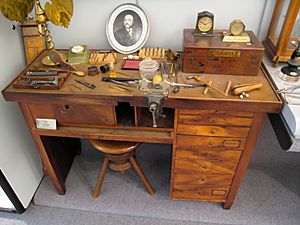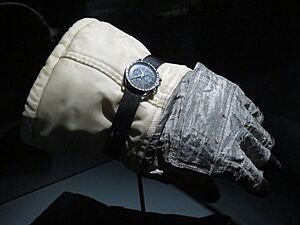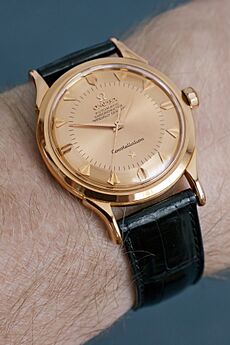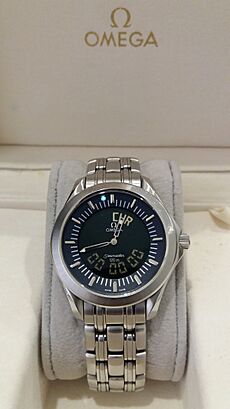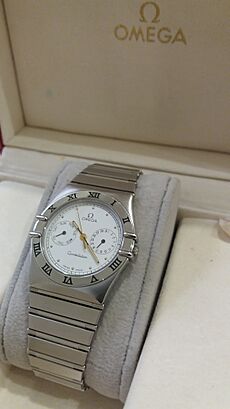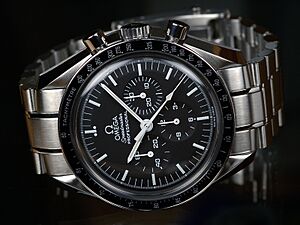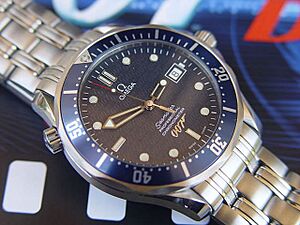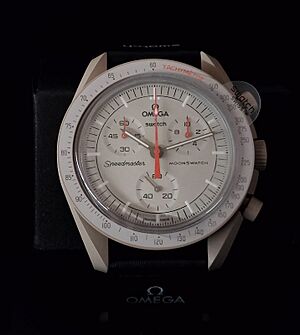Omega SA facts for kids
 |
|
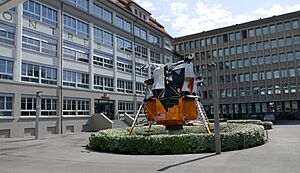
Omega's headquarters in Biel/Bienne, Switzerland
|
|
|
Native name
|
Omega Société Anonyme (SA)
|
|---|---|
|
Formerly
|
|
| Subsidiary | |
| Industry | Watchmaking |
| Founded | 1848 in La Chaux-de-Fonds, Switzerland |
| Founder | Louis Brandt |
| Headquarters |
,
Switzerland
47°08′37″N 7°15′36″E / 47.14362°N 7.25998°E |
|
Area served
|
Worldwide |
|
Key people
|
Raynald Aeschlimann (President) |
| Products | Watches, timing devices and systems |
| Parent | The Swatch Group |
Omega SA is a famous Swiss company that makes fancy watches. It is based in Biel/Bienne, Switzerland. Louis Brandt started the company in La Chaux-de-Fonds in 1848.
The company's name changed a few times. In 1903, it became Louis Brandt et Frère-Omega Watch & Co. Then, in 1984, it officially changed to Omega SA. Omega is now part of The Swatch Group, a big company that owns many watch brands.
Omega watches have been used in important moments. The British Royal Flying Corps used them in 1917. The U.S. Army used them in 1918. Even NASA used them for the Apollo 11 mission in 1969. The Omega Speedmaster Moonwatch is famous for being the first watch worn on the Moon.
Omega is also the official timekeeper for the Olympics. They first did this in 1932. They also time the America's Cup yacht race.
Contents
The Story of Omega Watches
How Omega Started
In 1848, Louis Brandt started his watch company in Switzerland. He made pocket watches by hand, using parts from local craftspeople. He sold his watches all over Europe.
In 1877, his sons, Louis-Paul and César, joined the business. The company's name changed to Louis Brandt & Fils. By 1894, his sons created a new way to make watches. They made sure all the parts could be easily swapped. Watches made this way were sold under the Omega brand.
The Omega brand became so popular that in 1903, the company officially changed its name to the Omega Watch Co.
Changes and Growth
After Louis-Paul and César Brandt passed away in 1903, their young relatives took over. Paul-Emile Brandt, who was not yet 24, led the company. During World War I, it was tough for businesses. So, in 1930, Omega joined with another watch company, Tissot, to form a group called SSIH.
Under Paul-Emile Brandt's leadership, SSIH grew a lot. It bought or started about 50 other companies. By the 1970s, SSIH was the top watch producer in Switzerland. Omega was even selling more watches than Rolex, its main competitor. Omega was known for new ideas, while Rolex was famous for its classic mechanical watches.
However, in the 1970s, a "quartz crisis" happened. Japanese companies like Seiko started making cheaper, very accurate watches using quartz movements. This made it hard for Swiss mechanical watchmakers. Rolex kept making expensive mechanical watches. Omega tried to make quartz watches too.
Modern Times
The SSIH group faced money problems in the early 1980s. Banks had to help them. Another big Swiss watch company, ASUAG, also had financial troubles. In 1983, ASUAG and SSIH merged to form a new holding company.
Two years later, a group of investors led by Nicolas Hayek took over this company. It was renamed SMH, and later, in 1998, it became The Swatch Group. Today, The Swatch Group owns Omega and many other watch brands like Blancpain and Swatch.
Omega became very popular again by showing its watches in movies, especially the James Bond 007 films. James Bond used to wear a Rolex, but in the movie GoldenEye (1995), he switched to an Omega Seamaster. This helped Omega become a strong competitor to Rolex once more.
In 2022, Omega worked with its sister company, Swatch, to create a more affordable version of the famous Omega Speedmaster Moonwatch. This "MoonSwatch" is made of a special material called bioceramic and costs much less than the original. As of 2024, Omega has over 350 stores around the world.
How Omega Makes Watches
Cool Inventions and Patents
- In 1892, Louis Brandt made the world's first wristwatch that could chime the time (a "minute repeater"). It is now in the Omega Museum.
- In 1947, Omega created a special watch movement called the 30I tourbillon. This was a very advanced design for its time.
- In 1999, Omega made history by using the "coaxial escapement" in many of its watches. This invention by George Daniels helps watches run smoothly for a long time without much oil. It also makes them more accurate.
- In 2007, Omega introduced new coaxial movements, the Calibres 8500 and 8501, made only by Omega.
- In 2013, Omega announced the first watch movement that can resist very strong magnetic fields. This means the watch stays accurate even near magnets.
- In 2015, Omega started its "Master Chronometer Certification." This means a watch has passed many tough tests for accuracy, water resistance, and magnetic resistance.
Precision Tests
Omega has a long history of making very accurate watches. They often took part in "observatory trials." These were competitions to see which watch could keep time most precisely. Omega's watches often won top prizes.
For over ten years (1958–1969), Omega made the most COSC-certified chronometers. A chronometer is a very accurate watch. Omega's slogan, "Omega – Exact time for life," came from their success in these trials.
Omega set many precision records over the years:
- 1894: Omega's 19 caliber movement was first tested.
- 1919: Won first prize at Neuenburg trials.
- 1925: Won first place at Kew-Teddington trials.
- 1931: Won first place in all 6 categories at Geneva trials.
- 1936: Set a precision record at Kew-Teddington that lasted until 1965.
- 1950: Won first place for its tourbillon movement at Geneva Trials.
- 1974: The Omega Marine Chronometer was certified as the world's first very accurate marine chronometer wristwatch.
Reference Numbers
Omega uses special codes to identify its watches. Before 1962, it was a simple code of two letters and four numbers. From 1962 to 2007, they used the Mapics system, which had two letters and six or seven numbers. Since 1988, they also used the PIC system with eight numbers. Today, they use the PIC14 system, which has 14 digits.
Famous Omega Watches
- A special Omega wristwatch owned by Elvis Presley was sold for over $1.8 million in 2018. It was given to him for selling 75 million records. The Omega Museum bought it.
- An Omega Stainless Steel Tourbillon watch sold for about $1.43 million in 2017.
- In March 1965, the Omega Speedmaster was approved by NASA for all space missions. On July 20, 1969, Buzz Aldrin wore his Omega Speedmaster when he stepped onto the Moon. This made it the first watch on the Moon.
Important Moments for Omega
Space Exploration
The "Omega Speedmaster Professional Chronograph" was first worn by astronaut Wally Schirra in 1962. NASA chose it in 1965 to be the only watch certified for all its space missions. All astronauts on later NASA missions used this hand-wound watch.
First Watch on the Moon

The Omega Speedmaster Professional Chronograph was the first watch worn on the Moon. Buzz Aldrin wore it. While Neil Armstrong was the first to step on the Moon, he left his watch inside the Lunar Module as a backup. So, Aldrin's Speedmaster was the first watch on the Moon.
Armstrong's watch is now in a museum. Sadly, Aldrin's watch was stolen. In 2007, Omega released a special edition of the Speedmaster to celebrate its 50th anniversary.
Deepest Diving Watch
As of May 2019, an Omega Seamaster Planet Ocean Ultra Deep Professional watch holds the record for the deepest dive. It went down to 10,925 meters (about 35,843 feet) in the Challenger Deep, the deepest part of the ocean. Two of these watches were attached to a special submarine called Limiting Factor.
Famous People Who Wear Omega
Many famous people wear Omega watches. These include actors like George Clooney, Daniel Craig, Nicole Kidman, and Cillian Murphy. Singers like Elvis Presley and even leaders like Joe Biden and John F. Kennedy have worn them.
Omega Sponsorships
In Movies and TV
- In the TV show NCIS, the main actors wear Omega Seamaster Planet Ocean watches.
- Omega was the official timekeeper for the video game Need for Speed II in 1997.
- In the TV show Kojak, the main actor wore an Omega Time Computer One, which was an early LED watch.
James Bond Movies

Omega has been linked to James Bond movies since 1995. When Pierce Brosnan became James Bond in GoldenEye, he started wearing an Omega Seamaster. The movie producers wanted Bond to have a more modern, sophisticated look. Omega was happy to have their watches featured in such a popular film.
For the 40th anniversary of James Bond in 2002, Omega made a special edition watch. It looked like the one in the movies but had a 007 logo.
Daniel Craig, who played James Bond in later movies, also wears an Omega Seamaster. In Casino Royale, he even mentions Omega by name. Omega has released many special James Bond watches over the years, with unique designs and 007 symbols. For Craig's last Bond film, No Time to Die (2021), Omega created a special Seamaster made of titanium, with a British military logo.
Sports Sponsorship

Omega has often been the official timekeeper for the Olympics. They timed the games in 2006, 2008, 2010, 2012, and 2016. They will continue this partnership until at least 2032. Olympic swimmer Michael Phelps is an Omega Ambassador.
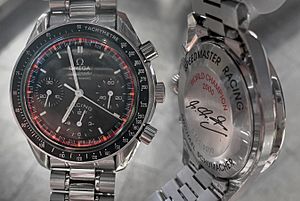
Omega also supports sailing, like the America's Cup yacht race. They made a special watch for Emirates Team New Zealand in 2007. Since 2011, Omega has been the official timekeeper for the PGA of America, which organizes golf tournaments. They also sponsor other golf events like the Dubai Desert Classic.
See also
 In Spanish: Omega (relojería) para niños
In Spanish: Omega (relojería) para niños
- Coaxial escapement
- List of watch manufacturers


